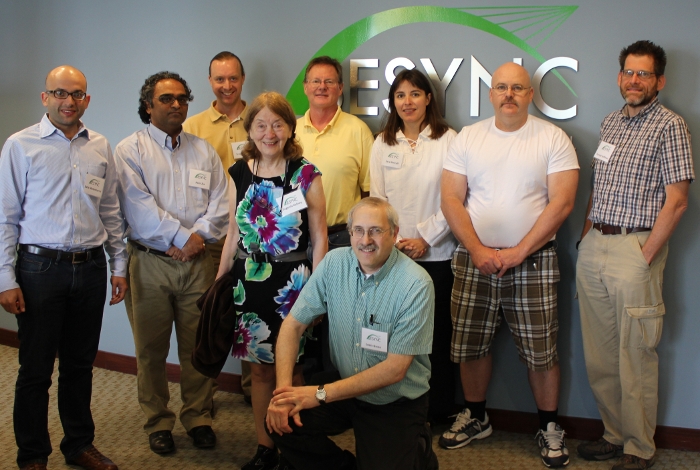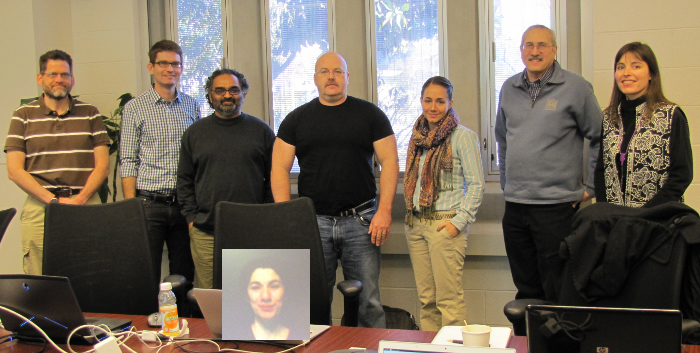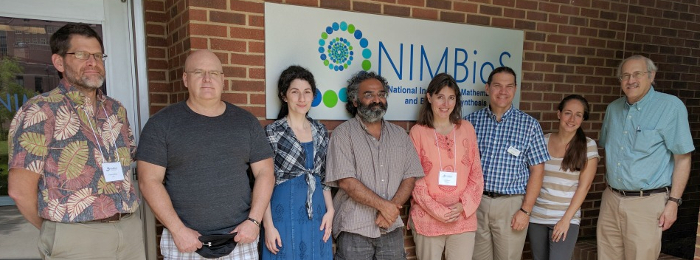| Description | Participants | Summaries | Products |
|---|

Joint NIMBioS-SESYNC Working Group:
Human Risk Perception and Climate Change
Topic: Integrating human risk perception of global climate change into dynamic earth system models
Meeting dates: June 24-26, 2013 (SESYNC); January 21-23, 2014 (NIMBioS); June 9-11, 2014 (SESYNC); July 28-31, 2015 (SESYNC); July 25-27, 2016 (NIMBioS)
Organizers:
Brian Beckage, Plant Biology, Univ. of Vermont
Louis Gross, NIMBioS and Univ. of Tennessee
Sara Metcalf, Geography, The State Univ. of NY, Buffalo
Asim Zia, Community Development and Applied Economics, Univ. of Vermont
Objectives: Anthropogenic emissions of greenhouse gases (GHGs) over the past two centuries have resulted in rapid climate change. Understanding the potential dynamics of the climate system is a critical challenge as GHG emissions continue. We propose to link models of human belief systems concerning risk associated with climate change with models of the ecological and climate systems into a coupled earth system model. In this earth system model, human belief systems and corresponding climate governance will drive anthropogenic GHG emissions that force the climate system, while the magnitude of climate change and related extreme events will influence human perception of associated risk.
The dynamics of the climate system are integrally linked to the dynamics of individual mental models (IMMs) and communal belief systems (CBSs) regarding climate change and its risks. IMMs and CBSs influence policy, climate governance, and ultimately anthropogenic GHG emissions. If individuals do not perceive climate to be changing or unmitigated climate change to pose a risk, then they are unlikely to advocate for potentially costly policies that promote alternative carbon-neutral energy and infrastructure technologies. An individual's beliefs are influenced by beliefs of those in their social network, so that individuals collectively form a communal belief system. Governmental actions and policy with respect to climate governance are ultimately driven by IMMs and CBSs of constituents and policy makers.
The climate system, in turn, influences individual mental models and communal belief systems. Extreme weather events or nonstationary climate change that is outside of an individual's experience of normality can shift IMMs and CBSs, ultimately influencing policy, climate governance, and GHG emissions. The future trajectory of this complex, coupled system depends on human belief systems, and their resistance to change, with respect to the risk posed by climate change. This integrative, multidisciplinary team will consider feedbacks between climate, ecological, and human belief systems using a quantitative modeling approach.
 This project is a joint activity between The National Socio-Environmental Synthesis Center (SESYNC) and The National Institute for Mathematical and Biological Synthesis (NIMBioS).
SESYNC working group page
This project is a joint activity between The National Socio-Environmental Synthesis Center (SESYNC) and The National Institute for Mathematical and Biological Synthesis (NIMBioS).
SESYNC working group page

Summary Report
This group currently consists of the following contributing individuals: Adam Schlosser (MIT), Ann Kinzig (Ariz. State U.), Asim Zia (U. Vermont), Brian Beckage (U. Vermont), Eric Carr (NIMBioS), Forrest Hoffman (ORNL), Jonathan Winter (Columbia U.), Katherine Lacasse (Clark U.), Louis Gross (UTK), Nina Fefferman (Rutgers U.), Peter Howe (Utah State U.), Sara Metcalf (SUNY Buffalo), Travis Franck (Climateinteractive). It thus includes a mixture of ecologists, mathematicians, climate scientists, geographers and social scientists.
The Working Group has focused its efforts at several levels of modeling to account for human risk perception and how this might be incorporated in climate models. This is a novel component of climate modeling, which has to date incorporated human behavior indirectly through economic impacts only. An overall objective, aside from the desire to assess alternative means to combine human social system models with climate models, is to provide a rational basis to determine whether human risk perception and associated changes in behaviors can significantly affect climate projections. The group has considered several alternative methods to account for human behavior, including agent-based models, system dynamics models framed as ordinary differential equations or difference equations, structured social system models in which the human components incorporate different subgroups with differing behaviors and transition rates between groups, and network modeling of belief systems in social networks.
Primary results of the work to date include development of a system dynamics model for risk perception based upon the theory of planned behavior. This theory from social science provides general approaches, not framed mathematically, to account for several distinct aspects of human behavior including attitudes towards impacts of behaviors, perception of social norms, and perceptions about the capability for behaviors to be effective and to have impact on controlling a system. The Working Group has developed a model (PACE - Perception, Attitude, and Carbon Emissions) that implements a version of the theory of planned behavior and integrates it with a climate model (CROADS). After publication of the results from this integration, the model will be released as a package that allows users to consider alternative scenarios. The primary focus of the modeling efforts to date have been consideration of the potential for human behavior to modify future carbon emissions and the associated impact on global mean temperatures.
Still under active development by the Working Group are papers on a combined network and game theory model for social influence of different belief systems, a structured model that accounts for differences regionally in social system beliefs and associated behaviors, and an agent-based model that can account for numerous details of human belief systems and impacts on behavior as it might modify climate impacts.
 |
| Meeting 1 participants. (Back row, L to R): Travis Franck, Robert Glass, Sara Metcalf, Brian Beckage, Forrest Hoffman; (Front row, L to R): Safa Motesharrei, Asim Zia, Eugenia Kalnay, Louis Gross; (not pictured: Rob Axtell, Nina Fefferman, Ann Kinzig, C. Adam Schlosser, Jonathan Winter). |
 |
| Meeting 2 participants (L to R): Forrest Hoffman, Peter Howe, Asim Zia, Nina Fefferman (foreground, via Skype), Brian Beckage, Katherine Lacasse, Louis Gross, Sara Metcalf. Not pictured: Travis Franck, Ann Kinzig, C. Adam Schlosser, Jonathan Winter; (not pictured: Eric Carr). |
 |
| Meeting 5 participants (L to R): Forrest Hoffman, Brian Beckage, Nina Fefferman, Asim Zia, Sara Metcalf, Eric Carr, Katherine Lacasse, Louis Gross. |
NIMBioS Working Groups are chosen to focus on major scientific questions at the interface between biology and mathematics. NIMBioS is particularly interested in questions that integrate diverse fields, require synthesis at multiple scales, and/or make use of or require development of new mathematical/computational approaches. NIMBioS Working Groups are relatively small (up to 10 participants), focus on a well-defined topic, and have well-defined goals and metrics of success. Working Groups will meet up to 3 times over a two-year period, with each meeting lasting up to 2.5 days.
A goal of NIMBioS is to enhance the cadre of researchers capable of interdisciplinary efforts across mathematics and biology. As part of this goal, NIMBioS is committed to promoting diversity in all its activities. Diversity is considered in all its aspects, social and scientific, including gender, ethnicity, scientific field, career stage, geography and type of home institution. Questions regarding diversity issues should be directed to diversity@nimbios.org. You can read more about our Diversity Plan on our NIMBioS Policies web page. The NIMBioS building is fully handicapped accessible.
NIMBioS
1122 Volunteer Blvd., Suite 106
University of Tennessee
Knoxville,
TN 37996-3410
PH: (865) 974-9334
FAX: (865) 974-9461
Contact NIMBioS


